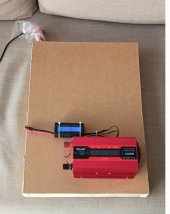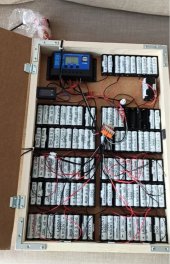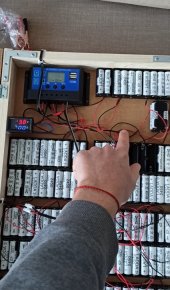Greetings solar enthusiasts,
I wanted to show something I built half year ago and which I felt shy to show given its rarity and to some extend, lack of sense.
Surrender to the AA powerwall!!! A set of 10S 11P NiMh 1,2V cells with a total of almost 27Ah capacity able to supply (as experienced for now) a constant 70W AC while using a DC/AC power inverter and a constant 300W when directly drawing from DC.
This rather than a "usable" installation is a model or toy. Thanks to the low voltages and stability of NiMh AA batteries I have been able to make mistakes without overheating or exploding components. However, nowadays I have permanently attached a small solar panel to it (50W); removed the inverter and added a distribution port with multiple 5V USB connectors and 12V connectors and I use the battery for my office corner to charge electronics, use lights (12V bulbs) and a small 150W-300W heater for those days where the temperature is on the edge. Obviously, when I use the heater, the battery is drawn in no time (30min), as well as cells get a bit warm. NiMh cells can handle decent currents >1C but are not meant to be used this way. Ideally no more than 0,5-1A.
The model includes a small LCD display with a switch that I can use on demand to verify the input voltage of the panel and the incoming current, so I can not only verify that the battery is being charged but I can optimize the panel inclination and positioning.
At this moment I am exploring ways to utilize 12V DC as for finding more uses to the battery. My lightning consumes only 5W per bulb, phone 10W and laptop 50W via inverter which I do not often need. With summer arriving in Europe and the longer days, I often have surplus of energy. My next addition is a 130W heating element for warming up water and prepare tea.
No BMS, aiming to manually balance the pack maybe once a year with a AA battery charger. The battery is full at 14,4V and discharge has to be stopped at 10V. NiMh cells allow to be discharged down to 5% theoretically with no sever damage.
Why I mentioned it makes not much sense; is because it is a heavy and bulky battery pack compared to its capacity and power. Also more expensive per Ah compared to LiFePO alternatives and mainly pursued due to donation of the cells.
All comments and suggestions are welcome. Ask what you like.
I wanted to show something I built half year ago and which I felt shy to show given its rarity and to some extend, lack of sense.
Surrender to the AA powerwall!!! A set of 10S 11P NiMh 1,2V cells with a total of almost 27Ah capacity able to supply (as experienced for now) a constant 70W AC while using a DC/AC power inverter and a constant 300W when directly drawing from DC.
This rather than a "usable" installation is a model or toy. Thanks to the low voltages and stability of NiMh AA batteries I have been able to make mistakes without overheating or exploding components. However, nowadays I have permanently attached a small solar panel to it (50W); removed the inverter and added a distribution port with multiple 5V USB connectors and 12V connectors and I use the battery for my office corner to charge electronics, use lights (12V bulbs) and a small 150W-300W heater for those days where the temperature is on the edge. Obviously, when I use the heater, the battery is drawn in no time (30min), as well as cells get a bit warm. NiMh cells can handle decent currents >1C but are not meant to be used this way. Ideally no more than 0,5-1A.
The model includes a small LCD display with a switch that I can use on demand to verify the input voltage of the panel and the incoming current, so I can not only verify that the battery is being charged but I can optimize the panel inclination and positioning.
At this moment I am exploring ways to utilize 12V DC as for finding more uses to the battery. My lightning consumes only 5W per bulb, phone 10W and laptop 50W via inverter which I do not often need. With summer arriving in Europe and the longer days, I often have surplus of energy. My next addition is a 130W heating element for warming up water and prepare tea.
No BMS, aiming to manually balance the pack maybe once a year with a AA battery charger. The battery is full at 14,4V and discharge has to be stopped at 10V. NiMh cells allow to be discharged down to 5% theoretically with no sever damage.
Why I mentioned it makes not much sense; is because it is a heavy and bulky battery pack compared to its capacity and power. Also more expensive per Ah compared to LiFePO alternatives and mainly pursued due to donation of the cells.
All comments and suggestions are welcome. Ask what you like.






